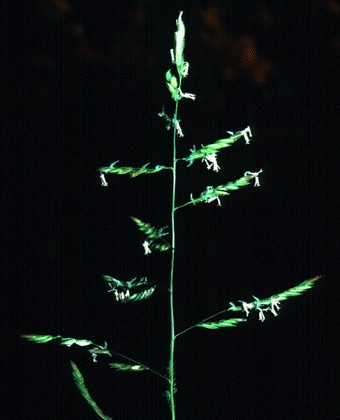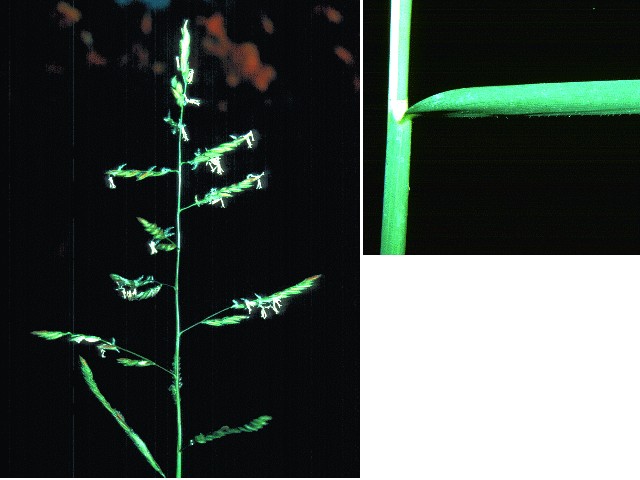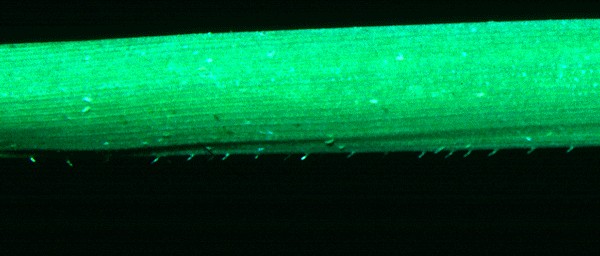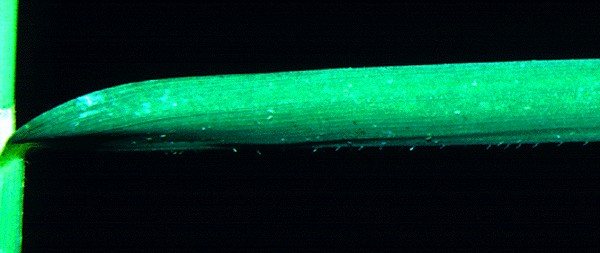Leersia hexandra (southern cut grass)
Identity
- Preferred Scientific Name
- Leersia hexandra Swartz
- Preferred Common Name
- southern cut grass
- International Common Names
- Englishswamp rice grass
- Spanisharrocillo rosadohieba de arrozlambedora (Dominican Republic)lamedora (Nicaragua)pasto de agua
- Local Common Names
- Brazilandrequicearroz-bravoarroz-de-Guianacapim-marrecagrama-boiadeiragrama-de-brejo
- Japantaiwanashikaki
- Thailandyaa sai
- EPPO code
- LERHE (Leersia hexandra)
Pictures

Inflorescence
Panicles terminal, 5-15 cm long, exserted, branches 3-13 cm long, filiform, ascending to somewhat spreading in more robust forms, usually one per node but sometimes two.
©Chris Parker/Bristol, UK

Inflorescence
Panicles terminal, 5-15 cm long, exserted, branches 3-13 cm long, filiform, ascending to somewhat spreading in more robust forms, usually one per node but sometimes two.
©Chris Parker/Bristol, UK

Leaf and leaf hairs
Leaves of L. hexandra are very rough to the touch, with retrorse hairs on the underside of the midrib.
©Chris Parker/Bristol, UK

Leaf and stem
Culms 25-150 cm long, decumbent, glabrous to coarsely scabrous near the nodes; blades 5-25 cm long, 3-5 mm wide, scabrous to nearly glabrous above and beneath.
©Chris Parker/Bristol, UK
Distribution
Host Plants and Other Plants Affected
| Host | Host status | References |
|---|---|---|
| Camellia sinensis (tea) | Main | |
| Hevea brasiliensis (rubber) | Main | |
| Oryza sativa (rice) | Main | |
| Saccharum officinarum (sugarcane) | Main | |
| Zea mays (maize) | Main |
Prevention and Control
Introduction
The choice of control method depends upon the size of weed infestation, the cost of labour, the value of the crop, and the cost and availability of herbicide.Methods that are commonly used to control perennial grasses and that can be used for L. hexandra include: preparation of a clean seedbed; rotation of rice with lowland, non-irrigated crops; tillage methods, i.e. ploughing, to destroy rhizomes; and applications of systemic herbicides, such as glyphosate, with attention to the selectivity of the herbicide: for example, if the crop is susceptible to glyphosate then apply it pre-planting (Ampong-Nyarko and De Datta, 1991).Other methods that have proved useful in the control of weeds in wetland rice are: closer row spacing to increase crop competition; thorough hand weeding; and burning stubble during the dry season (Moody, 1982).
Chemical Control
Glyphosate (pre-planting and post-emergence), fenoxaprop-ethyl (post-emergence), fluazifop-butyl and fluazifop-P-butyl (post-emergence) and imazapyr (pre- and post-emergence) may be used for control. Rates of application will vary depending upon the crop and the timing of application: for a full description of weed control in rice, see Ampong-Nyarko and De Datta (1991). See also Soerjani et al. (1987) for further information on chemical control in Malaysia.
Integrated Pest Management
RiceA range of control methods is used in the management of weeds in rice. The following descriptions illustrate the factors that are important for weed control in wetland rice systems. The list is not comprehensive: for further details, see Ampong-Nyarko and De Datta (1991).Land PreparationLand preparation is important in all rice cultivation and contributes to good weed management. Methods used will vary according to the crop system, especially concerning the management of perennial weeds. In transplanted rice, ploughing and puddling to destroy weeds and incorporate them into the earth provide a major source of weed control. In dry-seeded wetland rice and direct-seeded rice, land is prepared by ploughing and is kept weed-free before use, either by hand weeding or by herbicide application. Use of herbicides will be determined by the water management of the cropping system: for instance, in dry-seeded rice, after land preparation, weeds are allowed to emerge and are then destroyed either by shallow cultivation or with a non-residual contact herbicide, such as paraquat; in transplanted rice, puddling is followed by a pre-planting treatment with glyphosate on emergent weeds. In dry-seeded wetland rice, a pre-planting herbicide, such as glyphosate, or a pre-crop-emergence herbicide, such as imazapyr or fenoxaprop, could be used. CultivationTaller rice cultivars with more tillers shade out weeds and reduce weed competition. Rotation of rice with other crops, such as jute (Corchorus sp.), can be important in reducing the build-up of large populations of perennial grass weeds. SpacingRice planted with close spacing (e.g. 15 x 15 cm) will shade weeds and reduce competition, while still allowing some mechanized weed control if required (Moody, 1982).Hand WeedingAdditional hand weeding is usually done early in the season, during the critical period and, if weed populations are high, then later hand weeding is a common practice. If labour is scarce, herbicides such as glyphosate, applied locally to weeds only, or bensulfuron or fenoxaprop are used. Hand weeding alone can give as good weed protection as herbicide use: for example, in rice that is direct seeded onto wet soil, seeds are sown onto a weed-free field and two or three timely hand weedings are sufficient to ensure optimum yields (Moody, 1982; Ampong-Nyarko and De Datta, 1991).SugarcaneCultivation followed by hand weeding has been shown to give sufficient control of L. hexandra in sugarcane (Keya, 1980).
Impact
L. hexandra constitutes one of the aquatic weed flora of flooded rice of South-East Asia and has been described as a serious weed of rice in Guyana and Brazil and a principal weed of rice in Madagascar, the Philippines and Sarawak (Holm et al., 1977). It occurs as a weed of wetland, flooded or irrigated rice in Cambodia, India, Indonesia, Malaysia, Nigeria, Suriname and Thailand. It is a serious weed of tea in Indonesia. It has also been reported as a weed of maize in Indonesia and of sugarcane in Australia, the Philippines and Tanzania (Holm et al 1977). In north-west Nigeria, L. hexandra is reported as increasing in importance as a pest in lowland rice (Imeokparia, 1989)Usually, L. hexandra will be one of several weeds that cause problems in rice; therefore, yield losses cannot usually be attributed to L. hexandra alone. Ampong-Nyarko and De Datta (1991) reported estimates of 44-96% yield losses caused by uncontrolled weed growth, depending on the method of rice culture.L. hexandra plants indirectly limit crop production by serving as hosts for organisms that adversely affect rice; this weed provides food, shelter and reproductive sites for insects, nematodes, pathogens and rodents (see Biology and Ecology). Yield losses attributed to these factors are difficult to determine.In addition to competition with rice for resources, L. hexandra is also a problem associated with blockage of irrigation ditches.
Information & Authors
Information
Published In
Copyright
Copyright © CABI. CABI is a registered EU trademark. This article is published under a Attribution-NonCommercial-NoDerivatives 4.0 International (CC BY-NC-ND 4.0)
History
Published online: 21 November 2019
Language
English
Authors
Metrics & Citations
Metrics
SCITE_
Citations
Export citation
Select the format you want to export the citations of this publication.
EXPORT CITATIONSExport Citation
View Options
View options
Get Access
Login Options
Check if you access through your login credentials or your institution to get full access on this article.


